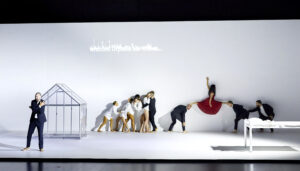
Opera Australia 2024 Review: Orpheus and Eurydice
By Gordon WilliamsPhoto credit: Keith Saunders
Opera Australia’s 2024 season at the Sydney Opera House continued on January 12th with a beguiling production of Gluck’s 18th century “Orpheus and Eurydice.” Originally a co-production between Opera Queensland and acrobatic troupe Circa, which Opera Australia now offered as their contribution to this year’s Festival of Sydney, this is a summer event that annually offers another reason to look forward to the warmer season.
The Orpheus myth dates back more than two thousand years and tells of the father of music Orpheus’s grief at the death of his wife Eurydice; of the permission granted to him to travel to the Underworld to retrieve her on condition that he not so much as glance at her on the return journey; and of his failure to stick to that condition, only to lose her again, this time forever.
The idea of a mythical musical figure who charms his way into the Underworld is obviously inspirational to musicians. One of the most aurally arresting moments in this production was Orpheus’s Act two attempt to gain entry to Elysium, the sudden eruption of Jane Rosenson’s harp color in the pit which is presumably Orpheus’s alluring lute, and the Opera Australia Chorus’s initial vocal rebuttal, stentorian “Non”s from the Furies guarding the Underworld. An important thing to note about Australian-Chinese conductor Dane Lam’s interpretation was the surprising freshness of moments like this, moments that anyone familiar with the opera would have been ready for.
But there’s more than musical inspiration to this story of the minstrel who can’t resist the temptation to look back at his revived wife and thus extinguishes the object of his love.
Director Yaron Lifschitz, Artistic Director and CEO of Circa, wrote intriguingly of the Orpheus myth’s juxtaposition of death and desire in his program essay and these two poles might be thought to have inspired the two planes of expression interwoven in fascinating combination throughout this presentation of the story. Music spoke to choreographed acrobatics and vice versa. The characters of Orpheus were powerfully presented by French countertenor Christophe Dumaux and Euridice/Amore (OA chorus-soprano Sandy Leung standing in brilliantly in this doubled-role on opening night in place of an indisposed Cathy Di-Zhang). They moved through the set as if through a world of stressed imagination. Christophe Dumaux’s Orpheus was a particularly galvanizing presence, riveting for example in his interjected cries for the already-dead “Euridice” in the production’s opening moments.
In the 18th century, Gluck and his librettist Ranieri de’ Calzabigi sought to strip the ornate older form of opera, “opera seria,” down to the essentials of drama and story-telling. But they were also influenced by the opéra-ballets of Rameau and other predecessors. Choreography had a more narrative role than mere geometric configurations. In a sense, Lifschitz and fellow-choreographer Bridie Hooper’s acrobatics paid tribute to this aim, certainly adding something far from the “static and passionless” performances that David Garrett writing on his website, “Notes from the Garrett,” regrets that Gluck has all too often become.
There were moments when abstruse movement intersected with story narrative but then offered striking lucidity. Gluck’s telling of the myth begins with Eurydice dead, so too Circa’s: Eurydice hung over straps strung from the ceiling by which she gradually came down to the stage. Toward the end of the 80-minute performance, a line of women in red (all Eurydices in Lifschitz’s telling) collapsed in turn as Orpheus turned them around, a striking image which made additional sense after reading Lifschitz’s gloss on the story in the printed program (see below).
But Lifschitz sought “steaming entrails of desire” in the stage movement and this made for an intriguing kind of super-counterpoint, beyond the purely sonic combinations that the musical term “counterpoint” usually denotes. The opera audience gasped as bodies were flung around or toppled from human towers, and yet the story remained exceptionally clear and to the fore in keeping with Gluck and Calzabigi’s vision.
Seeing Dane Lam conduct offered a visual embodiment of the rhythmic impulse coming from the pit that complemented the stage. His interpretation told. A person did not need to read the printed synopsis to know where the Acts fell; the orchestral weight said it all. There was an impressive architecture in Lam’s reading, note for example the way not overly-emphatic accents in the overture which accompanied the hanging Eurydice, grew to stabbing emphasis in Orpheus’s big Act three number, “Che farò senza Euridice,” Orpheus’s regret at finally losing Eurydice, and a musical pinnacle that Lam and Dumaux built toward. (Opera Australia presented the 1762 Italian-language Vienna version of the opera.)
Despite what may seem like an elusive complexity of meaning in this production, there was a wonderful simplicity to the production’s symbolism, particularly in costume designer Libby McDonnell’s use of colors and Alexander Berlage’s graphic lighting. At times the lighting seemed stark, strange counterpoint to Gluck’s urbane score, but then, as became gradually apparent, Lifschitz’s Orpheus is actually in an asylum. Orpheus is mad. No wonder the lighting was a cold fluorescent quality, at times.
Madness can be part of the original Greek myth too. In some versions Orpheus, gone mad with final loss of Eurydice, is torn to pieces by the Thracian women. Here, Orpheus’s madness was expressed, for example, in that idea that all women, even Amore, are Eurydices.
Perhaps it is simple-minded or at least presumptuous to quickly point to unequivocal correspondences in meaning between the different planes of expression in this production. It’s almost as if Lifschitz successfully portrayed the open-endedness of myth that gives rise to multiple meanings and interpretations and the sort of continual replenishment of significance that can last over two thousand years. Food for thought as Orpheus was hoisted above the stage.


